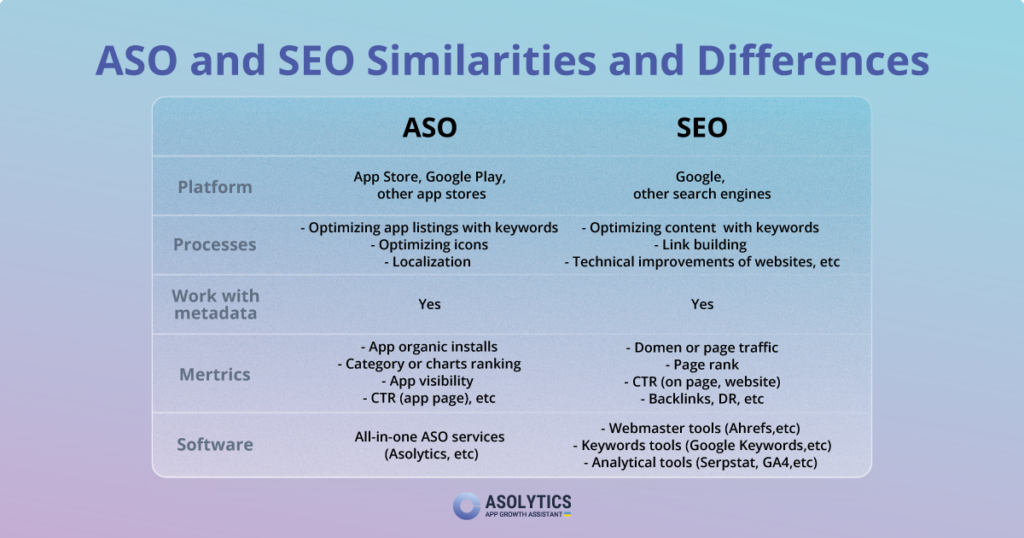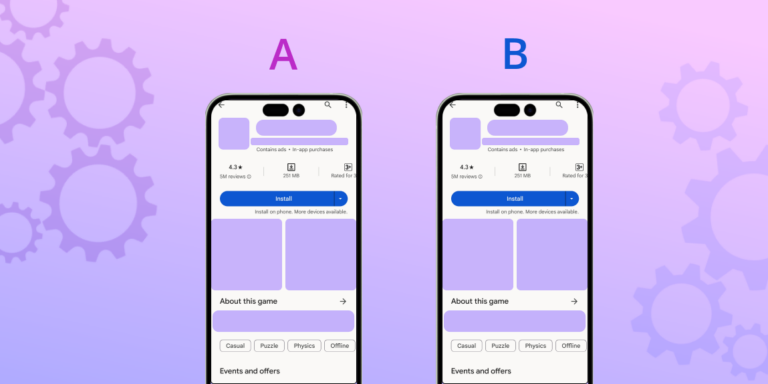‘The future of mobile is the future of online. It is how people access online content now’. These words by David Murphy, the co-founder and editorial director of Dot Media, have sparked a trend that continues to evolve. With the rapid growth of mobile apps, the digital marketing scene has witnessed the rise of a powerful force known as ASO.
As a business owner, it’s crucial to make your website as visible as possible to prospective customers. That’s where SEO (Search Engine Optimization) kicks in. SEO encompasses strategies to improve your website’s position on search engine results pages (SERPs). With regard to ASO (App Store Optimization), it’s a different way of attracting leads to your business. And in this post, we’ll be talking a lot about it. Before reading the article, we recommend that you familiarize yourself with the ASO vocabulary.
Many people have been ‘friends’ with SEO for a while, but the majority of them only exchange occasional niceties with ASO. SEO is the popular kid at the digital marketing party, while ASO is the intriguing newcomer everyone wants to get to know better.
So, is ASO merely SEO for apps? Are these digital marketing domains in a competitive relationship? Can a SEO strategy be seamlessly integrated into your ASO tactics? In this post, we’ll provide in-depth answers to these questions and dwell upon the ASO vs SEO comparison in detail.
In a nutshell, below, we’ll cover the following topics:
- SEO and ASO definition;
- their one-for-all ultimate goal;
- how ASO and SEO are similar;
- why ASO is not SEO for apps;
- the nuances of how people search on the web and in app stores;
- the difference between ASO vs SEO;
- metrics to use when measuring ASO vs SEO performance;
- our expert opinion on what’s easier to implement: SEO or ASO;
- considerations on what’s budget-friendlier;
- reasons why it’s best to use both Search Engine Optimization and App Store Optimization;
- major SEO vs ASO mistakes, what they lead to, and how to avoid them;
- how SEO and ASO can effectively work together.
Table of Contents
ASO vs SEO: Defining Both Notions
The term App Store Optimization relates to the techniques employed to enhance an app’s discoverability on platforms such as Google Play and the App Store. These days, ASO is vital for dev teams. Think of it as a booster that helps your app outrun other apps in the search queue. It’s what helps your app pop up like a jackpot when people go hunting in the app stores. If your ASO is top-notch, your app becomes a breeze to discover and download!
With regard to SEO, it refers to a set of tools for increasing your website’s visibility in search engines and thus stimulating your business growth. According to Guy Kawasaki, an American marketing specialist, author, and Silicon Valley venture capitalist, ‘If you have more money than brains, you should focus on outbound marketing. If you have more brains than money, you should focus on inbound marketing.’ While ASO may pose data-backed counterarguments to that claim, the quote is definitely about high-quality content-based SEO. Long story short, SEO does require a hell of a brain and experience to achieve undeniable success.
It’s All About Getting Noticed
Boosting your app’s downloads in a natural way is like matchmaking — it’s all about connecting with those who crave what your app offers. Think of search results as the ultimate matchmaker. When potential users hunt for something specific, your app can be their perfect match if it pops up in the right searches. So, getting noticed in those search results isn’t just a fling; it’s a download-worthy connection waiting to happen.
App Store Optimization and Search Engine Optimization share a common goal: propelling your product to the top of search results. While App Store Optimization zeroes in on searches within app marketplaces like the App Store and Google Play, Search Engine Optimization tackles web-based search engines, notably Google, to ensure your online presence shines.
Both SEO and ASO implement strategies of using keywords in strategic places to ‘assist’ search algorithms in finding and positioning your app at the top of the search results. Goal-wise, they look in the same direction. But when it comes to user intent (what people are on the prowl for) and implementations (what can be optimized), ASO and SEO are different. This calls for separate approaches to tackle each effectively. Now, let’s delve deeper into SEO vs. ASO comparison (as well as compatibility and competitiveness).
How ASO and SEO Are Similar
ASO and SEO may target different platforms — mobile apps and websites, respectively — but they share several striking similarities. Here’s a list of key similarities between ASO and SEO:
- Keywords are the main tool
Both ASO and SEO rely on identifying relevant keywords that potential users or visitors might use to find content. - Content is a catalyzation
In both disciplines, creating content that engages your users is crucial. In ASO, this involves app titles, descriptions, and screenshots, while SEO focuses on web page titles, meta descriptions, and on-page content. Content is what attracts users to your app page or web site, so the tool to optimize it is semantics. - Usability matters
Both aim to enhance the user experience. ASO considers factors like app performance, speed, and user reviews, while SEO looks at page load times and user engagement. - Competition evaluation
Both ASO and SEO involve monitoring competitors to understand their strategies and identify opportunities for improvement. Keyword research is mainly based on existing semantics being effective for your competitors. - Changeable algorithms
Search engines and app stores continually update their algorithms. Staying informed and adapting SEO and ASO strategy accordingly is paramount in both fields. - The perks of localization
ASO and SEO benefit from localization efforts. Adapting content and keywords for different regions or languages can boost visibility and engagement. - Analysis is everything
Both rely on data analysis and tracking to measure the effectiveness of strategies — and prevent bumps in the road like inadequate mobile optimization or heavy ASO cannibalization. - Never-ending improvement
No matter the strategy you opt for, remember that ASO and SEO are not one-off endeavors. They require ongoing dedication to sustain and enhance outcomes. This holds true because app stores and search engines frequently revise their algorithms and standards while competitors continuously refine their optimization techniques.
For this reason, it’s essential that website and app developers conduct regular assessments of their app and website performance, as well as that of their competitors, in order to identify and execute modifications aimed at bolstering their rankings and visibility.
While both ASO and SEO strategies focus on increasing visibility, the App Store fee is a unique factor in ASO that does not have a direct counterpart in SEO, affecting how developers strategize for visibility in app stores. We hope that answers your ‘How are ASO and SEO similar?’ question. Now, let’s start delving into the differences.
SEO Is Not ASO for Apps: Here’s Why
App store optimization focuses exclusively on apps and has limited overlap with SEO. Google Play Store and Apple App Store, the two biggest app marketplaces, function as merchandising engines, not as search engines. They aim to connect your app resources with the right user groups within their ecosystems.
That said, there are more vital factors at play:
- in SEO, the main emphasis lies on keywords, content, backlinks, and technical elements, whereas ASO revolves around optimizing app listings;
- while popular mobile apps can achieve rankings for thousands of keywords concurrently, web pages tend to center their efforts on a select few key concepts and keywords simultaneously;
- the behavior of app store users tends to shift frequently, whereas web users generally demonstrate stable and classifiable behavior pattern;
- app store search trends often diverge significantly from Google searches. The vocabulary employed by users to discover items in app stores rarely corresponds to their search engine queries;
- in most cases, Google exhibits a slower pace in modifying its search results, while search results within app stores have the potential for rapid and substantial changes from day to day.
App Stores vs. Web: How People Search
A significant contrast exists in how individuals conduct searches in app stores compared to the web. As a general rule, web users commonly manifest four separate search intents. We’ve listed them below:
- informational: the focus here is on exploring, uncovering, and contrasting different types of information, seeking to understand processes such as ‘how to make vanilla cupcakes’’ and the like;
- commercial: it emerges when individuals aim to research services, products, or brands, as seen in queries like ‘best vanilla cupcakes manhattan;’
- navigational: it comes into play when users intend to access specific websites through their search queries, as observed in phrases like ‘magnolia bakery cupcakes yelp;’
- transactional: when users are on the prowl to purchase something, e.g., ‘buy vanilla cupcakes.’
With that said, web ‘surfers’ intend on doing something, learning new stuff, and taking particular actions. In contrast, app store users are mostly searching for products, tools, and services. And while both app store and web search queries may sound similar, they’ll definitely return different results. Now that we’ve touched upon all these nuances, you know how differently people search on the web and in app stores — and how different the returning search results are.
ASO vs SEO: Innovation-Igniting Distinctions
App Store Optimization and Search Engine Optimization are two distinct yet interconnected disciplines, each tailored for their respective platforms. Understanding their divergences is paramount for marketers and developers. Below, you’ll find a list of major distinctions between the two disciplines.
- Platform priority
ASO is geared towards mobile apps, optimizing their visibility within app stores. SEO, on the other hand, concentrates on web
content, aiming to improve a website’s ranking in search engine results. - Keyword research
ASO relies on keywords relevant to the app’s functions, features, and user intent within the app store. SEO involves keyword research that targets web content, aligning with user search queries on search engines. - Metadata optimization
ASO optimizes app titles, descriptions, and screenshots, primarily for app store listings.
SEO focuses on optimizing webpage titles, meta descriptions, header tags, and on-page content. - User reviews and ratings
ASO heavily considers user reviews and ratings to influence an app’s visibility and credibility.
SEO does not incorporate user reviews as a ranking factor. - Conversion metrics
ASO tracks metrics like app installs, click-through rates (CTR), and conversion rates within the app store. SEO measures website metrics such as click-through rates, bounce rates, and time on site. - Localization specifics
ASO localization may involve adapting content for different languages and regions within the app store. SEO also benefits from localization but focuses on web content translation and regional targeting. - Localization specifics
ASO emphasizes app engagement metrics like session duration, retention, and in-app purchases. SEO focuses on user engagement with website content, including dwell time and interactions. - Long-term goals vs. quicker gains
ASO offers fairly short-term marketing impact, whereas SEO builds for the long haul. Which one to opt for depends on your priorities and resources. Focus on SEO if you can commit the necessary time and effort. If you seek a speedier marketing approach with a focus on paid traffic outcomes, then App Store Optimization might be your best bet. - ASO vs. SEO software
SEO and ASO are sibling strategies, but their toolkits differ. For SEO, you have popular tools like SEMrush, Moz, and Ahrefs, which excel in keyword research, backlink analysis, and site auditing. On the other hand, ASO benefits from tools like Sensor Tower, App Radar, and Mobile Action, specialized in tracking app rankings, user reviews, and competitor data. For comprehensive ASO solutions, give Asolytics tools a try — they’re tailor-made for app store optimization, ensuring your app conquers the app market landscape.
With all that said, the ASO SEO comparison is a lot more than meets the eye. While they share some principles, their specialized techniques cater to the unique demands of app stores and search engines, respectively. Overall, SEO and ASO stem from a common optimization team but exhibit distinct mindsets. You need to understand these mindsets for tailoring effective strategies in each domain.
We’ve now ascertained that SEO and ASO are not competitor notions. Expanding on this, we can affirm that, with some persistence and experience, SEO and ASO optimization can effectively complement each other.

Analyzing ASO vs SEO Performance
Measuring the performance of both App Store Optimization and Search Engine Optimization is vital for evaluating the effectiveness of your digital marketing efforts. Here’s a comprehensive guide on how to measure ASO, along with key performance indicators (KPI) to constantly monitor and analyze.
Your ASO KPI to track are as follows:
- Keyword Rankings. Monitor your app’s rankings for target keywords within app stores. The Asolytics keyword tracking tool or Mobile Action can help you with monitoring.
- App Downloads. Measure the number of app downloads over time, as it directly reflects the success of your ASO efforts.
- Conversion Rate. Analyze how many users who view your app’s page actually download it. A high conversion rate indicates effective optimization.
- User Reviews and Ratings. Assess user feedback and ratings to understand user satisfaction and areas for improvement.
- Retention Rate. Track how many users continue to use your app after the initial download. Higher retention indicates successful ASO.
- Competitor Analysis. Compare your rankings, downloads, and reviews with competitors to identify strengths and weaknesses.
- Click-Through Rate. Measure the percentage of users who click on your app’s listing when it appears in search results.
- Keyword Performance. Evaluate which keywords drive the most traffic and downloads to your app.
You can track and analyze your app performance and competitors’ ones in Asolytics:

Now, with regard to the SEO metrics to keep tabs on, find them below:
- Keyword Rankings Analyze your site’s rankings on search engine result pages for target keywords. Tools like SEMrush and Ahrefs may come in handy.
- Organic Traffic Measure the volume of organic traffic your website receives from search engines like Google.
- CTR. Analyze the CTR for your organic search results to assess how compelling your listings are.
- Bounce Rate Analyze the percentage of visitors who leave your website without engaging with its content. The lower bounce rate the better user engagement.
- Conversion Rate Measure how many visitors take a desired action on your website, such as making a purchase or signing up for a newsletter.
- Backlinks Keep track of the quantity and quality of backlinks to your website, as they influence SEO rankings.
- Page Load Speed. Evaluate how quickly your website pages load, as faster loading times positively impact SEO.
- Content Performance Assess the performance of your content, including page views, time on page, and social shares.
- Competition Assessment Compare your SEO rankings, traffic, and backlinks with competitors to identify areas for improvement.
By consistently monitoring and analyzing these metrics, you can get to grips with the effectiveness of your ASO and SEO strategies, make conscious improvements, and achieve better visibility and rankings in both app stores and search engines.
SEO and ASO Optimization: What’s Easier to Implement?
Implementing either SEO or ASO depends on various factors, including your goals, resources, and expertise. Let’s compare the ease of implementation for each and understand why one might be easier than the other. We’ll start with SEO:
- SEO covers websites and content across the entire web, allowing for more extensive reach and audience diversity;
- it often takes time to see significant improvements in search rankings, which can be a drawback for those seeking immediate results;
- SEO involves a more complex landscape, including on-page optimization, backlink building, technical SEO, and content strategy;
- search engine algorithms frequently change, requiring ongoing adjustments and updates to maintain rankings;
- depending on the industry, competition for top search rankings can be fierce, making SEO a challenging endeavor.
Now, let’s take a closer look at ASO, complexity-wise:
- ASO is specific to mobile apps and concentrates on optimizing app store listings, which can be more straightforward due to the narrower scope;
- changes in ASO tactics can often lead to more immediate improvements in app visibility and downloads;
- ASO relies on metrics like app downloads, user reviews, and ratings, which are more straightforward to track;
- the app marketplace can be less competitive than web search, depending on the app category, providing opportunities for easier visibility;
- while app store algorithms evolve, they still tend to change less frequently than search engine algorithms, reducing the need for constant adjustment.
There’s no definitive answer when it comes to comparing the ease of use and effectiveness of ASO and SEO. Both approaches demand a particular level of expertise and familiarity with the algorithms and criteria of the platforms they’re applied to. Implementing ASO may be somewhat less challenging for mobile app creators because app stores evaluate a more confined and specific set of content and metrics in contrast to search engines. On the other hand, SEO has the potential to be more impactful in terms of elevating website traffic and improving visibility because search engines encompass a larger scope and assess a broader range of content and metrics.
SEO and ASO: What’s More Expensive?
The cost comparison between SEO and ASO depends on various factors, making it challenging to definitively declare one as more expensive than the other. Below, we’ll provide a breakdown of major considerations for both, starting with SEO:
- Content Creation. Developing high-quality content can be costly, especially if outsourcing to professionals.
- Quality Backlinks. Acquiring authoritative backlinks is far from cheap.
- Monitoring Tools. Utilizing SEO tools for analysis and optimization usually comes with subscription fees.
- Time Is Money. SEO requires continuous effort, which translates into labor costs for ongoing content creation and optimization.
Now, what about ASO expenses? Here’s a breakdown for consideration:
- Building a Semantic Core. In-depth keyword research tools may require a subscription fee.
- Polishing Visuals. Designing eye-catching visuals like icons and screenshots may have design costs.
- App Updates. Regular updates to maintain competitiveness may involve development costs.
While SEO can entail higher initial expenses, ASO’s ongoing nature can accumulate costs over time. Ultimately, the choice depends on your goals and budget specifics.
Reasons Why You Need Both SEO and ASO
With over 5 million apps available on both Google Play and the Apple App Store in 2023, the mobile app market is more crowded than ever. To stand out, combined SEO/ASO strategies to boost your app’s visibility are essential. Here are some more reasons why using both methods is a smart choice:
- SEO and ASO generate traffic from separate channels
SEO is the wise old sage of digital marketing, with over two decades of experience. In digital terms, it’s like the granddaddy who’s seen it all. ASO, a fresher optimization strategy, focuses on improving an app’s standing and discoverability in app store searches using keywords and other methods. The ultimate aim is to draw users in for downloads. Considering that most Android and iPhone users rely on app store searches to find apps, it’s crystal clear that despite being fresh and young, just like SEO, ASO deserves your full attention. - SEO and ASO address varied user intent
During online searches, users opt for lengthier, more specific search terms to efficiently navigate the immense pool of information and discover their desired content. A strong SEO strategy aims to seize the attention of these searchers by enhancing SERPs with carefully selected keywords that respond to popular searches.
When users search within the app store, they typically opt for concise, sometimes one-word terms, or they search by app name. In contrast to SEO, ASO keywords should zero in on a particular aspect or functionality of the app instead of long-tail keywords tailored for web search queries. Therefore, though both SEO and ASO utilize keywords for traffic enhancement, their approaches vary. - Different ranking factors
An essential reason to blend SEO and ASO into your broader app marketing strategy is their distinct ASO ranking factors. To make things more intriguing, iOS and Android play a bit of a ranking roulette with apps, each with its own set of rules. It’s like two different chefs using the same ingredients but cooking up unique flavors in the mobile app kitchen!
SEO has undergone a transformation in its two-decade journey. The focus has shifted from merely pleasing search algorithms to enhancing user experiences. This involves crafting captivating websites, working up top-notch content, incorporating links to reputable sites, and reducing loading times. While keywords and content remain paramount, their usage and search engine ranking methods have evolved.
Your SEO ranking checklist should encompass:
- utilizing relevant keywords within title tags, headers, and content;
- giving priority to top-notch, contextually fitting content;
- fine-tuning URLs and meta tags;
- boosting page load speed;
- adding links to and relevant sources;
- decreasing bounce rates;
- encouraging users to spend more time on a page.
Despite its shorter list of ranking criteria, ASO’s significance remains just as high. ASO’s core principles trace back to SEO basics, with a central emphasis on using keywords correctly. Finding the appropriate keywords demands a touch of expertise and substantial research effort. To elevate your app store ranking, prioritize:
- how you position keywords in the app name or title (iOS and Android);
- utilizing keywords in the app subtitle (iOS) or description (Android);
- composing an excellent detailed description (both);
- optimizing the keyword section (iOS).
However, ASO isn’t solely centered on keywords (though it would be convenient); other factors influencing your ranking consist of:
- the overall download count and download velocity;
- metrics related to usage and quality;
- download statistics;
- uninstallation frequency;
- app crashing rate;
- backlink volume (Android).
At the end of the day, ASO excels in the app-focused environment, optimizing discoverability and user acquisition, while SEO dominates web searches, driving website traffic and online visibility. Combining their strengths provides a comprehensive approach, doubling your chances of success on the always-changing digital scene.
7 SEO Mistakes to Watch Out For
Even the sharpest minds may occasionally dull after extensive use against the digital marketing surface. Let’s take a look at some SEO blunders, where missteps always lead to lessons learned. From keywords gone wild to low-quality content, we explore the biggest mistakes made by marketers in their quest for online glory — and what these mistakes usually lead to.
- Overlooking mobile optimization
Ouch! This one is costly. It alienates a substantial portion of users who browse on mobile devices. This oversight leads to reduced traffic, lower rankings, and missed business opportunities. - Keyword overload: yikes! It’s unreadable!
Keyword overstuffing in SEO is detrimental because it degrades user experience, making content appear spammy and ‘inhuman’. It can lead to penalties from search engines, plummeting rankings, and loss of credibility. Quality content should prioritize user value over keyword density to foster engagement and trust with the audience. - Low-quality content
Let’s say you’re working on a plastic surgery clinic website. What if you use low-quality content with mistakes or factual errors as you expand your inbound marketing efforts? As a result, you’ll put your credibility at risk and deter potential patients seeking trustworthy information about procedures and practitioners. This will lead to reduced traffic, higher bounce rates, and a plummet in search engine rankings, ultimately harming the clinic’s online reputation. You don’t want that outcome, do you? - Ignoring technical SEO
Technical issues like slow loading times, broken links, and crawlability problems negatively impact user experience. This leads to higher bounce rates, reduced search engine rankings, and ultimately, a loss of potential customers and revenue. - Forgetting to analyze
This epic blunder leaves marketers blind to their website’s performance. Analytics provide valuable insights into user behavior, traffic sources, and content effectiveness. Without this data, it’s impossible to make informed decisions for optimization, contributing to a website’s growth and competitiveness in search engine rankings. Forgetting to analyze (or rather ASO-lyze) is a mistake that exists on the ASO scene, as well. - Neglecting local SEO
It’s a significant SEO mistake because it limits a business’s visibility to local customers. For instance, a small bakery in Los Angeles that doesn’t optimize for local search may lose out on attracting nearby residents searching for, say, ‘best bakeries in la,’ . Naturally, this will result in a missed customer base and revenue. - Not optimizing for voice search
It’s a major SEO mishap in the era of smart speakers and virtual assistants. Picture a local pizza joint ignoring voice search. It misses out on customers who ask their devices for ‘pizza delivery near me,’ leaving their commercial ovens cold and profits untouched.
7 ASO Pitfalls to Avoid
Setting out for your ASO journey often has more twists and turns than a rollercoaster. By exploring 7 potential pitfalls provided by our experts below, you will succeed in avoiding the app-ocalypse and ultimately master the art of App Store Optimization.
- Not prioritizing keyword research
This highly unprofessional approach leaves your app without a strategic compass in the app store wilderness. Keywords are the map to your app’s discovery. Failure to research and include relevant keywords leads to poor visibility, reduced downloads, and missed opportunities to connect with your target audience. - Disregarding user feedback
User reviews are a goldmine of insights into your app’s strengths and weaknesses. Ignoring them means missing out on valuable feedback, which could help improve your app, boost ratings, and increase user satisfaction. Engaging with reviews fosters user loyalty and enhances app visibility. - Failing to prioritize visual content
Your app store listing visuals are the first impression of your app. Poorly optimized icons, screenshots, or feature graphics fail to capture users’ attention and trust. Engaging visuals enhance your app’s click-through rate and conversions. Ignoring this aspect diminishes your app’s appeal and competitiveness in the app store. - Clinging to download numbers as the sole metric
While downloads indicate visibility, they don’t guarantee user satisfaction or long-term engagement. Focusing solely on downloads may lead to low-quality users, increased uninstall rates, and missed opportunities for monetization. Quality metrics like app retention rate and user reviews provide a more holistic view of app success. - Non-updating your app
Regular updates improve app performance, fix bugs, and add new features, enhancing user experience. An outdated app risks losing users’ interest and trust. Keeping your app fresh and updated is essential for maintaining engagement and a positive reputation. - Improper localization
Neglecting cultural nuances, language variations, or local preferences alienates potential users in different regions. For instance, a global fast-food chain’s app that fails to adapt its menu and promotions to local tastes and languages may struggle to connect with diverse audiences, limiting its potential growth. - Not conducting A/B testing
Without A/B tests, you’re left guessing what changes resonate with users. A/B testing helps identify the most effective strategies for improving click-through rates, conversions, and user engagement. Not conducting these tests means missing out on valuable optimization opportunities.
Now that you’re well-aware of the fundamental mistakes in SEO and ASO, along with the consequences of these mistakes, you can easily construct a strategic checklist for sidestepping these traps. Remember, it’s all about nonstop optimizing for success, not settling for errors that can easily be avoided (or corrected).
How ASO and SEO Can Work in Tandem
Search Engine Optimization App Store Optimization may seem like two distinct entities, but they can harmoniously coexist and even strengthen each other when integrated into a comprehensive digital marketing strategy. Here’s how they can work together:
- By Benefitting From Keyword Synergy Identical or closely related keywords can be used for both website content and app listings, enhancing visibility across search engines and app stores.
- By Boasting Top-Level Content High-quality content, favored by search engines, can also improve user engagement within the app, contributing to better ASO metrics.
- By Reaping Perks From Backlinks Quality backlinks directed to your website can indirectly boost your app’s authority, reflecting positively in ASO rankings.
- By Killing Two Birds With One Stone High website engagement brings more positive app reviews and higher retention rates. It’s a win-win situation. And no one gets killed, by the way.
- By Demonstrating Brand Consistency Maintaining a consistent brand image and a uniform message across both web and app platforms enhances brand recognition and trust.
- By Cross-Promoting! Utilize your website to promote your app, and vice versa, increasing cross-platform user acquisition.
Wrapping It All Up: Key Takeaways & Tips
In the grand digital arena, the showdown between App Store Optimization and Search Engine Optimization has been dissected, compared, and debated. As we wrap up our exploration, let’s distill the key takeaways and essential tips from this duel:
- ASO and SEO cater to different platforms — mobile apps and websites, respectively. Understanding this distinction is paramount;
- both rely on effective keyword research, despite with divergent intents and implementations;
- ASO targets app store users with shorter, specific queries, while SEO tackles a broader range of web user search behaviors;
- ASO considers user reviews and in-app metrics, while SEO leans on backlinks and content quality;
- when used in tandem, ASO and SEO can amplify each other’s impact, fostering a robust online presence;
- both ASO and SEO demand ongoing commitment, as algorithms evolve, competitors innovate, and user behavior shifts;
- regularly monitoring performance metrics is indispensable in both domains.
To cut a long story short, SEO does have the gravitas of a seasoned elder in digital marketing. ASO, in its turn, is the agile, new kid on the block. ASO in SEO together create a powerful duo that confidently dominates the vast digital landscape, one search query at a time.
FAQ
What is the difference between SEO and ASO?
The main distinction between the two disciplines lies in their focus and platforms. Search Engine Optimization targets websites for web search engines, like Google, to enhance online visibility. App Store Optimization concentrates on mobile apps, improving their visibility within app stores such as Google Play and the App Store, catering to the mobile environment.
What is the ASO SEO strategy?
Both strategies involve optimizing content to boost visibility. ASO enhances mobile app discoverability within app stores, focusing on keywords, visuals, and user reviews. SEO optimizes websites for web search engines, emphasizing keywords, quality content, and backlinks to improve online discoverability. Both strategies aim to rank higher in relevant searches.
What is an example of ASO in SEO?
Think of a situation when a website offers a mobile app alongside its web content. The website’s SEO strategy focuses on optimizing its web pages for relevant keywords. Simultaneously, the ASO strategy ensures the mobile app’s listing on app stores is optimized with relevant keywords, visuals, and user-friendly content to boost its visibility and downloads, complementing the website’s SEO efforts.
How is ASO and SEO similar?
They are similar in their fundamental goal i.e. improving visibility via keyword and content optimization. Both strategies require ongoing investments of time and effort to maintain and improve rankings. These similarities make ASO and SEO the Batman and Robin of digital marketing, working closely together to make sure that your successful marketing story goes on and on.




